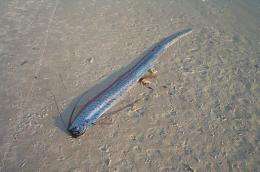February 10, 2010 report
Bizarre giant oarfish filmed (w/ Video)

(PhysOrg.com) -- A rare giant oarfish, probably the largest bony fish in the ocean, has been filmed off the Gulf of Mexico. This is possibly the first time the fish has been observed in its natural environment.
The oarfish (Regalecus glesne) can reach up to 17 m (55 ft) long. It has rarely been seen before, and then only when dying on the surface or washed up on shore, dead. It is the longest fish known and has a prominent, undulating dorsal fin, and it may have spawned the ancient tales of sea serpents.
Professor Benfield and his team filmed the oarfish at over 1500 feet deep during a Serpent project survey in the Gulf of Mexico. The project is run by marine scientists in collaboration with oil companies like Shell, BP and Chevron. The team used remotely operated vehicles (ROVs) supplied by the energy companies to survey the waters deep under the Thunderhorse semi-submersible oil rig.
The scientists initially thought the 5-10 meter (15-30 ft) long fish was a pipe riser dropped by the energy companies. It was vertical and shiny, and looked like a big riser nearby, but as they looked closer and saw it moving they realized it was an oarfish. It swam vertically downwards tail first when the ROV approached. The vehicle followed the oarfish for around five minutes and then resumed the survey.
Professor Benfield said to his knowledge the oarfish had never before been seen alive in the ocean’s mesoplagic layer (200-1000 meters deep), although there was a possible sighting in 2007 at 765 meters deep off the coast of Africa. He said the fish’s swimming behavior was particularly interesting because it undulated its dorsal fin in waves, and that drove it backwards at “quite a good speed”.
During the project the team also filmed the behavior of a manefish (Paracaristius sp.) for the first time in its natural habitat, and this sighting was reported in the Copeia journal. Manefish are normally only seen dead in trawls, and Benfield said in that state they are “incredibly beat up,” but in its natural environment it is a good swimmer, with fins splayed out like a parachute. The manefish is thought to feed on, or take food from, a siphonophore, which resembles a jellyfish, and which has tentacles that could damage the fish. This could explain the precise control the fish has over its position and orientation.
The Serpent project is run by the National Oceanography Centre, Southampton (NOCS). Professor Benfield said he hopes the project will establish a system for deep-sea observation, with numerous ROV-equipped rigs and ships surveying the Gulf.
Mark Benfield is a professor with the Department of Oceanography and Coastal Sciences at Louisiana State University, Baton Rouge in the U.S.

More information:
-- Journal paper: www.asihcopeiaonline.org/perls … abstract&doi=10.1643%2FCI-08-126
-- Wikipedia article: en.wikipedia.org/wiki/Oarfish
© 2010 PhysOrg.com















